The Real Market With Chris Rising – Ep. 4 Andrew McDonald
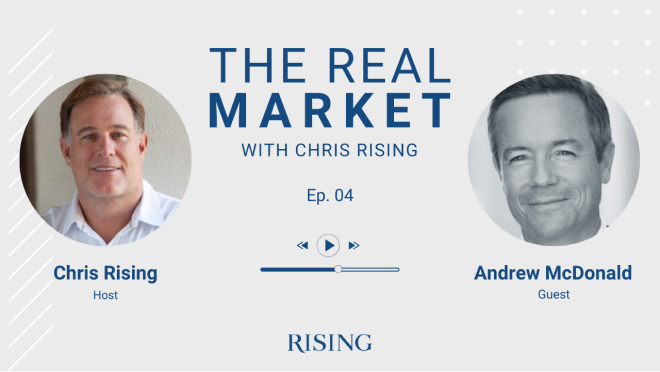
00:50 CR: I’m really excited to have Andrew McDonald on the podcast today. Andrew is the president of the western region for Cushman & Wakefield. He’s an old friend, one of my dearest friends and we have a lot of stories because we were really fortunate as young real estate professionals to be working at 601 South Grand in the office of the president at Cushman Realty. So we got to spend a lot of time with a real estate legend in John C Cushman III. So we talk a little bit about that in our podcast today, we talk about where Cushman & Wakefield is today, what the firm is doing? Andrew dives into what’s happening in the Western US markets and talks about what he sees as the growth in these markets. So I’m really excited about this conversation. I’m really grateful that Andrew would spend the time here on the Real Market with Chris Rising.
01:50 CR: I’m really pleased to have my dear friend, long, long friend. I don’t wanna say old because I don’t want to date us but I’m very lucky to have my friend Andrew McDonald. Andrew is the president of the Western region for Cushman & Wakefield. For anybody who’s followed the real estate industry over the last 10 years or so, I think we’ve all watched the evolution of brokerage firms from CB to JLL as well as Cushman & Wakefield. So I’m very pleased to have Andrew, who represents the Western region for Cushman & Wakefield which really represents west of Texas and it includes Mexico. And all business lines report up to Andrew. So Andrew, welcome to the Real Market with Chris Rising.
02:32 Andrew McDonald: Thank you very much, Chris. I’m really happy to be here.
02:34 CR: Well, thank you. Well, I’m excited to talk to you because we go back a long way, back to the old Cushman Realty days before there was a Cushman & Wakefield, and we’ve spent a lot of time in the real estate world together, but I’m excited to hear where Cushman & Wakefield is today. Could you tell me, just give me an update on what’s going on at Cushman & Wakefield? What’s the ownership like? I know a lot of your competitors are public and Cushman & Wakefield at this time is not public. So maybe just tell us a little bit about Cushman & Wakefield, kind of generally?
03:05 AM: Sure. So it’s a pretty exciting time as you just alluded to. You and I started at Cushman Realty Corporation, I started there in 1999, and then in 2001 the firm that we were at was sold to Cushman & Wakefield. Cushman & Wakefield was owned at different times by different types of private equity. It was owned by Mitsubishi and private equity. It was owned by an Italian private equity firm. Those were a little bit different times and they’re a little bit probably different private equity in the sense that they were true private, private equity. They were the own firm’s money. And we are now, since 2015 been merged with DTZ and the group that put that together in essence is our consortium of ownership is led by Texas Pacific Group. Ontario teachers pension plan is in there as well as a private equity firm out of Hong Kong called PAG, and what’s exciting about that is that’s, there is just a different sense of leadership. There is a different type of ownership involved with this private equity consortium.
04:16 AM: One that I think truly understands how to build a brand, one that truly understands how to build an international corporation, and one that understands a client service business. And so we’ve come quite a ways since you and I were sitting in cubes adjoining each other, but it’s a place where I think that there’s a ton of excitement. And you mentioned that a lot of our competitors are public and it’s true. The two real large competitors that we have are public and I think that ends up becoming a part of a lot of people’s thoughts about what our plans are. And what I do know is that there is a ability for us and there has been, and it’s been proven out in the last two years, an incredible ability to grow and to service clients in a way that we simply were unable to do so before our merger.
05:16 CR: That’s terrific. As you talk about growth, what do you see as the drivers of growth for a company specifically for Cushman & Wakefield? What’s gonna grow your business?
05:28 AM: Sure. Well, I think you’ve got to look at the different pieces of our business. I think you mentioned earlier that a brokerage firm and while we don’t stay away from being a brokerage firm, what we really are and what our large competitors really are, are real estate services firms. Brokerage is a key component of our business, business, but it’s by no means our entire business. To give you a little bit of a landscape on that and to put that in perspective, leasing and capital markets is a huge piece of the business.
06:00 AM: If you’re to separate those two out, it would be, leasing is probably twice the size of capital markets, but combined they are just around 60%, 64% of our entire global business, the balance of which is property and facilities management, evaluation, consulting, a few other service lines. So, the way you build it out is like a lot of businesses, that are certainly client focused as you take a look at your gaps within geographies, and where are you able to service clients on a consistent basis and where are you not. And so our growth is really in those areas, which is where can we continuously grow to service clients on a consistent basis, whether that’s in Asia or that’s in Western Europe or here in the United States.
06:45 CR: So when you look at…
06:45 AM: We spend a lot of time growing those sides of business, facilities management, evaluation, brokerage, capital markets.
06:54 CR: So when you look at the business today, how do you think it’s different today and what do you see as big changes in the way real estate services are provided today from even say five years ago?
07:07 AM: I think the easy answer is that technology has enabled information to be shared a bit more quickly and probably it’s been more democratic in its availability. I do think however that there is a lot of things that remain true. If you take the brokerage side of the business, you and I learned from a legend in the business and a lot of the colloquialisms that he would talk to us about, things like “the harder you work the lucky you get, the early bird gets the worm”, those things still remain true I think in all businesses and that would be true for a lot of our brokerage, but I will tell you that there’s been a monumental shift as it relates to what type of services clients demand, what they need is a better way to put it and what firms are able to provide.
08:02 AM: And so I think that an easy way to look at that is that as a lot of us have probably more experience on the brokerage end that is probably the side of the business that a lot of people compare what it used to be like versus what it’s like today and an example of that would be information as it relates to what spaces are available is simply not something that is difficult to come by today, least comparables are not difficult to come by today, they are free information as they should be. What tenants and occupiers and investors really require is a bit more of insight related to that information as well as service lines like if you’re an occupier, workplace strategy. I think the reality is, our business has just become far more complex and the delivery of those services requires those to be highly educated and be able to provide those.
09:13 CR: Well, I think you opened up a window there, talking about John Cushman that we’ll get to in a second because we can’t have a conversation about Cushman & Wakefield and not talk about triple sticks. But keeping it on the technology side, I think there is a lot of people who made the argument over the last few years that technology would take away the need for a brokerage firm, whether it’s an auction.com or whether it was at the time space and high tower. My perception is that everytime they say they’ve got, technology says they have the broker killer, what that really becomes is just another tool for the brokerage community. Do you see that differently or do you really see technology being a threat to your business?
10:00 AM: Well, I think that we’d all be foolish if we didn’t think that there were numerous existential threats to all businesses, I think that’s the reality of the world. So I absolutely do believe that those who are responsive to change are gonna be the most successful, I’m not the person who coined that, that’s been around for a long time. But the way that we view technology is, it’s really a partnership. So that’s probably a little bit more of what you were just getting towards. There are certainly, we keep our eyes out, every single day we have numerous skunkworks going on as we talk right now, with regards to what could be those threats, how do we either [A], combat; [B], partner with those. It’s something that is the top of mind of not just us but I think our entire industry.
10:53 CR: And do you think that technology is kind of a binary thing, either you have the best technology and you’re in a good spot or you don’t and you can never compete. How do you look at, when you’re looking at investment dollars, are you finding that you think that you’ve gotta take money from the balance sheet and get it into VC’s, or how do you guys look at investing or using technology?
11:21 AM: We’ve given that a great deal of thought, it is obviously something that again the entire industry has tried to find the right solution for. Our firm believes very strongly however that we are very good at what we do and I think our dollars are better spent with partnering with technology firms and that is the route that we have taken. So we have partnered with probably I think most people believe is the largest invest-investor accelerator in the prop-tech world, which is MetaProp out in New York and we think that partnering with them allows us to pivot, provide best solutions as they come about.
12:04 AM: Technology changes, as you know, relatively quickly. And so what we don’t think is appropriate for our investment dollars today is to buy those technologies. We think it’s better to partner with them. And that’s the route we take and it’s already been a huge success as it relates to some of the tools and companies that we’re using for our evaluation and advisory business, especially on those appraisals that are being done at lower margins, how do we automate those. So we have a really cool solution that we have started working with MetaProp on that.
12:41 CR: That’s terrific. I would say, the metaphor or the saying that it’s hard to teach an old dog new tricks is an understatement for successful real estate brokers. So how do you get more mature successful real estate brokers to buy into this idea that they really need to use technology whether it’s a service like BTS, which I know from the landlord side we find to be indispensable, or some of the property management softwares or… It’s more about people. How do you get people to be, at your company, to see the benefit and that you really just can’t do it out of a note card box like the old days?
13:22 AM: Well, I don’t think we actually have that many people probably still doing that. Of course there’s going to be some who are… Or holdouts. And I don’t begrudge them. I think it’s really a culture question, Chris. I really think it’s really one of… Do you have a culture that instigates curiosity, intellectual curiosity that happens… Some of that could be within the technology space, some of that could be in sales and enablement in different ways. But I think that if you build a culture where there’s an excitement surrounding investigating different ways of doing things, then it kind of takes care of itself, it kind of almost self policies. I think there’s this thought that there’s a bunch of, in essence, dinosaurs, if you will, people who have not changed their business practices for decades. And while I’m sure that is true, at some level, I don’t see it with any great regularity. At least I don’t see it any more or less than I’d see it in any other firm, whether it be legal or accounting.
14:31 CR: So the days of trying to convince people to use a smartphone are over. Everybody’s onboard with… They wanna use the kind of technology that’s gonna drive their business.
14:41 AM: We have individuals who celebrated their 50th anniversary with our firm who are as technologically savvy as some of the millennials who sit right by them, without a doubt.
14:52 CR: That’s terrific. Well, let’s move a little bit towards talking about some of the markets. And before we get into the markets, can you just describe what your role as president of the Western region means in terms of the markets that you’re in?
15:07 AM: Sure. So, the way that we are structured, is we have three regions in the United States, New York Tristate operates as its own. The East which is everything between New York Tristate and the State of Texas, so a lot of that’s in the central part of the United States, all the way down into Florida, is called our East Region. And then you have the West Region which is eight states starting in the furthest east of Texas, moving to California and up Washington, Oregon, includes Utah, Arizona, Nevada, Colorado. And Mexico falls under the West region, which I’m the president of.
15:49 CR: And where does Illinois, where does Chicago fit in all of that?
15:55 AM: Chicago fits in the East. And that’s our world headquarters, which when you and I were… When you were here Chris, we were headquartered in New York, and so now we are in Chicago.
16:06 CR: That’s gotta be a big change from the old days, just to move to the center of the country. But something that we’re seeing…
16:14 AM: It certainly… Yeah. [laughter] It doesn’t diminish the importance of Manhattan by any stretch of the imagination, but we did change our headquarters a couple of years ago.
16:23 CR: That’s terrific. So as you’re looking at the markets that you spend all your time with, can you give a little indication, what are the hot markets? What are the markets that you see either from the landlord side or maybe the tenant side, or you see the most excitement right now?
16:39 AM: Sure. Well, I think that if you just start east and move west, it’s hard to have any conversation in the United States about commercial real estate and not talk about Dallas. Dallas has been on fire for a number of years. When you… I don’t know if you were there for ULI, but it’s just astonishing when I went there to see the amount of cranes and that continues to this day. A lot, multi-family, but still office. We just moved our Dallas operations into a great building on the corner of McKinney and Olive, called McKinney and Olive, and it’s absolutely just the most beautiful building you can imagine. And Austen is obviously a fun market, a great market for us. And Houston, I’ll tell you, with energy not having its best year this year, our Houston office just knocked the cover off the ball there.
17:33 AM: The entire State of Texas is just really a fun one to work in and hard to really have any kinda conversation about any of the food groups of real estate and not talk about Texas. And then, I think that it goes without saying, that Northern California remains to be about as exciting of a market as there is in the world. There’s hardly a market that has, and can capture as much momentum in such a short period of time as San Fransisco and the environs, so it’s incredibly exciting. Some smaller markets that I think don’t get as much national play, but certainly investors, and I think that you’ve probably looked there at some length in detail, places like Salt Lake City. I was just there the other day. Salt Lake City is an incredibly fascinating market to me. One of the largest employers there, if not, the largest private employer is Goldman Sachs, you have incredibly low vacancy rates both in multi-family and in office, and retail has really come on strong in Salt Lake City.
18:45 CR: Well, and I think you also have to point to the investment in public transportation there.
18:49 AM: Exactly right.
18:49 CR: The fact that the airport is connected, I think that’s a huge thing.
18:53 AM: I agree.
18:53 CR: The universities, I think people forget that Provo, going up to Salt Lake, and then going north, up to Ogden, you’ve got, I don’t know, something like 200,000 students there that are just coming out of school excited, and really not wanting to leave that region. So I agree with you on Salt Lake.
19:13 AM: And that’s a stat that is just so important, that certainly a lot of people follow, but it’s that population of college graduates that do not want to leave, right? And that’s the reason why a place like Salt Lake City, a place like Denver, a place like Los Angeles, really will always be in the crosshairs of employers. And when you’re taking a look at, “Where would you locate your business?”, that’s amongst the most important statistic.
19:41 CR: Now are you spending any time in the Pacific Northwest? Either Seattle or Portland?
19:47 AM: Yeah, I am. I was just in Portland, and in Seattle. Portland is just a great market for us, and Seattle’s a market that’s probably one of our big growth markets for the next three years. We have a three year plan to grow that market. It’s a phenomenal market as you know, we kinda don’t even have to talk about it, only in the sense that it’s so well known, what’s come out of Seattle. But it’s not a market that right now we are operating at the level we need to be.
20:26 CR: Well, it’s an interesting market. We really track Seattle closely because it is so different than any of the historical patterns. So if you’ve been in the business since the ’80s or ’90s, you can’t even compare Seattle historically to where it is today, and I think that presents a lot of opportunity, and it also presents a lot of risk. Because if you’re just diving in and don’t understand why certain areas of Seattle have developed, I think you’re in for trouble. But I think it’s a market that isn’t going away, and there’s a lot of value with it being so close to Vancouver, I think towards international businesses. And obviously you’ve got two of the…
21:04 AM: Agreed.
21:06 CR: Yeah, two of the biggest companies in the world, between Amazon and Microsoft, and they are never leaving that as their headquarters, at least as far as I can tell. When you’re going through California, you talked a little bit about San Fransisco, but can you talk a little bit about what you see happening in say, the five markets of California? San Fransisco, Bay area, Silicon Valley, LA, Orange County, and San Diego?
21:29 AM: Sure. San Diego, you talk about how Seattle, you wouldn’t probably recognize it if you were going back, I don’t know if you said 10 or 15 years, but San Diego I would say the same thing as it relates to the types of businesses. San Diego is an incredibly diverse economy, and I think moreso than a lot of people think, and it’s not just biotech, and some technology that’s creeped in there, but it’s huge healthcare, it’s huge education, and it’s really, probably, I would say in California, it’s amongst our strongest as it relates to where we stand on the league tables. If we’re not one every year there, in almost every discipline, we’re pretty darn close. And that’s a function of our merger with… With the merger of DTZ and CNW in 2015, as both firms were extremely strong in that market. So it gives us an unusual, kind of, girth of practice there. But it is a great market, and where San Diego starts and stops, and Orange County starts and stops is starting to bleed into one another. You can say that for a lot of markets across the US, as you’ve seen things grow.
22:47 AM: And I would say the same thing as it relates to going over the border into Tijuana. So it’s a market that we remain hyper focused on, and is just a phenomenal place for us. Orange County, we have historically had one of our strongest offices in California, in Irvine, and we continue to, we just moved our offices there. I would say Orange County’s similar to San Diego, and it’s really kind of a California story, where you talk about the disparate economy, and what types of businesses are located there. I think it surprises people when they take a look at Orange County in general and see that how much business there is on the logistics side, how much business is there now on the entertainment side, and I think everyone uses technology as everything other than those things, but there is certainly a large population of businesses that have located in Orange County that are that confluence of content creation and technology. And so, we’re very bullish on Orange County. And I think for the lot of reasons that you already talked that have those smart city checkpoints, education, transportation, and the population spread that I think is very appealing.
24:19 CR: Yeah, we do all of our investing VS, what we call scorecards and if you don’t have a commitment to public transportation, we probably would not be an investor there, because we just think that the single occupant car destroys innovation, it destroys people’s willingness to wanna be creative, but also, we think it’s a statement about how a community wants to encourage people to interact. But we also then look at the education and we also look at the demographics, and I think clearly millennials and then this other group that follows millennials, which I don’t think anyone’s really named yet maybe it’s Gen Z. Figuring out where they wanna be, I would say when you talk about Orange County as much as we like the airport area. We’ve been amazed about the growth in Southern Orange County and Northern San Diego County, as a place where there’s talent, so if companies are gonna grow, that’s a place where you can get talent. Are seeing that as well?
25:23 AM: We are, we have a handful offices in San Diego and they stretch up to Carlsbad, so we have followed that by our own investments in where we’d locate our offices, so you’re absolutely right. What you need to start growing there is you need be able to aggregate a lot of space to be able to get some large employers in that mix, that North San Diego County area and I think that exist at some level, but needs to grow. But I agree with you that that is a location that I don’t think is going anywhere as it relates to how people view that especially that millennial and as you say, Gen Z.
26:07 CR: Yeah, and I think the reality of California even though we have, we are a high-tax state is that we’re becoming a kind of a barbell where it’s a great place for employers who have the ability to pay people well and then on the side where you want more of a minimum wage worker. It’s not a great market for kinda middle class workers. But if you’re talking about a market where people wanna live and where you can attract talent, it’s hard to beat Orange County in San Diego. What’s your take on Silicon Valley right now?
26:42 AM: Well, I think that there’s a lot of play right now and I think it, some of it is just headline grabbing as it relates to what firms and what people are moving from that part of the world down to Southern California, while I think that’s an interesting side note, I don’t necessarily think that’s a trend that people should be investing or using a thesis to invest in. But I think, I mean, to say that it’s strong is a little bit, it’s kind of like saying Ontario strong in industrial. It doesn’t give it enough credit. It is, you can choose what degree of hyperbole you wanna be on when you describe, in general, that market, but like all markets, you really need to understand the micro markets within them and I think that any investor that takes a look at “Silicon Valley as one market” is not using probably the best investment in criteria. I think that like all real estate and like all investors, you really honestly need to take a look at every single piece of the information that you have, whether it’s traffic patterns and historical and an access to housing. I think that that storyline is increasingly important and I think that if there’s any one thing that will cause that market to not be at its, perform at its optimum is housing. I would say the same for Los Angeles as well.
28:19 CR: Well, one of the interesting things about the role that you have is you not only see it from a user perspective, but you also see it from an owner perspective, but my question would be, I was fortunate to have Andy Cohen on the podcast recently and I also had Carl Muhlstein, and we spent a lot of time talking about, what is it that drives real estate decisions? Why are people, whether from the landlord side, from the owner side or from the tenant side, what is it that people are doing when they lease space today? Why even have an office today? And if you’re gonna have an office, what’s it look like? Could you address that kinda general theme?
29:00 AM: Well, I think the stats are probably a little daunting, right? I mean I think gig economy’s real. There’s an ever increasing percentage of the workforce who are not employees, so just start off with that, number one. I think the utilization of office space in many stats is dropping. I think the thing that’s most perhaps daunting of all of them is the amount of employees who feel disengaged. And so that’s a really difficult thing to understand what that means, but I do think what it means is that there is simply too much real estate that exist that is not engaging to those who work within it. And this is not my term, but it’s a term from another firm that calls, “how they can create an empathetic building.” And whether there’s true empathy with inside of the building, that’s for someone else decide. But I do think it’s the right thought process, and I would start with the fact that engagement with employees is literally, should be yours, should be mine, should be everyone’s number one priority.
30:08 AM: The real question is, as you said is, where does office space go from here? And I think just the very fact that we’re answering and asking that question is the right start. I don’t foresee a time where there is simply not a need for office space. But I don’t believe that we’re going to see a time where every firm outsources and does not have a need for their own home. So I don’t think we need to worry about cutting quite to the bone right there, but I do think that if you are not providing as a landlord, as an owner, and if you’re not providing as an employer, an environment where an employee can feel totally engaged in their day, and be efficient with their time, and you made the point earlier, have access to certain things, most importantly amongst them is public transportation, then I think that that piece of real estate and that particular business is not long.
31:10 CR: Yeah, the business has certainly changed. As you remember in the ’90s when we were working with John Cushman, we would do this headquarter tours and it was really the CEO, John, you, and I, and the decision was, does it go near his home, near his town club, or his country club? And everybody else can kinda just follow along. What we see today from the ownership side, from the landlord side is, these tours are now done by committee, it’s not even a HR person, everybody’s got a new name for what HR is. And one of the things that I think is a really good thing, but it’s really obvious is that space decisions are made by both men and women, people across different divisions in a company. I’m always blown away by how many people now come on tours than what it used to be. But from a service provider prospective, how are you talking to the decision-makers about, if they’re gonna start say a headquarter search, what’s the process that you would walk, say a major company through on what they wanna be thinking about as they look for a new headquarters?
32:20 AM: Well, that’s a big question, and it involves a significant number of people within our firm. It’s probably something like ourselves, and a couple of our competitors, who have similar resources, are very good at. It would begin in any number of actually different ways, but amongst the most important would labor analysis, we have an entire department dedicated simply to labor analytics. And it is a far more complex conversation than perhaps even just one podcast, but I will tell you that the analysis that goes into a headquarters relocation is significant, and I don’t, I agree with you that decisions are made certainly more by committee now, I would argue they’re probably made a significantly more about procurement, and HR versus a CEO, and access or proximity to any one individual’s home is really irrelevant, completely.
33:22 AM: I think a couple of things, Chris, I think that the reason why you see real estate selection and site selection process is taking a different route than they did even a decade ago is that real estate, finally on the private business end has followed a bit more of how retail has viewed real estate, there’s both an aspirational quality to it, or desire, and does it elevate not just my brand, but does it elevate and engage my employees? And I think that is why you’re seeing, thankfully, a much more democratic process as it relates to the conversation that is being had about site selection, but when it comes to hiring a real estate service firm at a large headquarters, it is not just labor analytics, but it’s going to be about what is it that any one city, or state, or region can provide that employee, or employer that others can not, and just like you take a look at investing, they do as well on a score sheet. If that’s helpful.
34:37 CR: No, it is. One of the things I think would be interesting to people is to understand… I think the one everyone’s talking about right now is where Amazon’s second headquarters are gonna go, but it’s really not that different than some of the big headquarters that I know Cushman & Wakefield has done recently, especially over the last few years. But I think what would be interesting to our audience is, how do things like carbon reduction or lead platinum or health and wellness, how do those things play when you’re talking about a major US corporation looking for headquarters?
35:17 AM: I can’t think of one, and I’m just gonna say major, I don’t know another word to call it. One call it a Fortune 500 firm, or if you take a look at their home page and take a look at their guiding principles or values, it doesn’t have the word sustainable in it or something that is a synonym. And Cushman & Wakefield will be the same. It used to be, perhaps, people paid a little more lip service than they do today and I think that’s a natural evolution, you’re not quite sure of what it truly means. But over the last 10, 15 years I think most firms understand clearly what that means and they understand what their responsibility is, what their footprint looks like. Our firm would not move into a building or move into a space where the interiors are not they’d certified. The office that I’m talking to you from within right now is well certified as well, and that’s quite the norm. So I think it’s incredibly important. I think it’s almost a table state, I think you kinda have to have.
36:19 CR: Well, it sounds like you would agree that we both think that there’s a reason to have an office, it defines your culture. I always equate it to sports teams, you gotta have a clubhouse, you gotta have a place where you can run into each other and talk and have ideas. But having said that, are you seeing whether it’s hoteling or technology for video calls and things? Are those playing into decisions on how much square footage people are taking when they do a headquarters?
36:53 AM: I think so. Yeah, absolutely. I don’t necessarily think it equates to a significant drop in footprint. I think there’s a lot of stats that show what exactly what law firms have gone through, but I think that’s sometimes not the right way to look at, not the right industry. That was always an industry that was compared to others, probably overofficed in a sense. There’s a lot of really interesting stats out there as relates to space utilization. One that I come back to, and this is well documented, and we’ve actually done our own, just internally at our own firm, we have 48,000 employees, we have a pretty good set up to survey that the younger the generation the higher the utilization of office space. That shouldn’t be that shocking ’cause I think what happens in a lot of professional services firms is, the older you get, or you can say the more experienced you get and perhaps the more successful you get, sometimes you don’t need to feel like you need to be in the office as often.
38:04 AM: And it’s those who are probably at a different stage in their career who do, plus there’s a community aspect of it, which really if there’s a good culture, there’s a desire to be a part of. I travel every week and I am never surprised now to walk into whether it’s our office in Austin or Seattle or San Diego, how many people are in that office on a Wednesday at 10:00 AM or 9:00 AM or at 6:00 PM? They’re full, and they could be working from home. But I think if you have the right culture, and I think that if you celebrate people and engage them, then it’s a wonderful way to build a community.
38:52 CR: I agree with you, I think it’s an interesting study as to how people use space because I think people are wrong on both ends. There are those who say, “Oh, people are using 100% all the time,” and there’s others who say, “It’s not being used at all.” And what I think you really find is it really comes down to the culture of the firm and the ones that are healthy and growing, the headquarters or the office spaces is really used but it’s certainly used differently. I mean, you don’t need to have the files that we used to so meticulously organize, you do that all now in the cloud, and I think people have accepted that. But the idea that you’re gonna have a meeting to discuss strategy and think it can be done over a box of a telephone, I just don’t agree with that. But I tell you, I wanna pick up on something you just said, you said you travel every week. So how does someone who runs a region as large as yours, how do you use technology to keep yourself effective and engaged with your employees and with your team members?
39:57 AM: Well, I could probably always be more efficient and more effective in my use of technology. But I try to travel in the beginning of every week, so Monday through Wednesday or Sunday through Tuesday or Wednesday of every week. And staying in touch there is… Every single one of our offices operates off of the same technology platform. We have no phones, every laptop is, in essence, its phone, so it’s all Skype for business. I carry a Microsoft Surface with me and that is, in essence, my phone, that is my office. All video capable, so every office I go into, very simple for me to have a video call. I do it every single morning, in fact. And so staying in front of people while it’s not face to face, it’s certainly screen to screen, I see their face and it’s helpful to communicate from distance but nothing, nothing beats face to face.
40:56 AM: Technology wise, everything as you said, everything’s in the cloud. I would say that there is just far too much email traffic. I think that we have all suffered from that and there’s many different ways to try solve for that, whether it’s setting aside times that you only look at emails, setting aside time where you simply do not allow emails or do not allow CCs. We’ve practiced all of those. Where we are in the growth of our company right now though, Chris, is that we are growing significantly, we’re in a different stage than some of our competitors, a very exciting one. And when you’re in that growth and build mode, there is a significant amount of information that is shared and needs to be accessed obviously. And so, I’m unfortunately probably a little bit too beholden to email more than I’d like to be right now and that’s something that I think I need to… Probably we all need to work on a little bit.
42:01 CR: Yeah, I think the biggest change in our company was about three years ago, four years ago when we moved internally over to Asana, which is a project management system that is Google-based and it works for us. But what made that work is when we had the commandment that you can’t email people with arising rp.com email address. All of that has to be done and it’s just changing people’s habits. Let the outside world be how we communicate and email, but internally if we can’t track it, you can’t measure it, you can’t hold people accountable. And I know that was a big change for us.
42:34 AM: That’s exactly right. That’s exactly right. Measurement dictates behavior. [laughter]
42:39 CR: You got it. That’s right. So as we get near the end here, we gotta go back to the triple sticks discussion. I know I have a few stories I always love to tell and when people ask me about working for John, I always say it was in a lot of ways, it was a blur because you just don’t stop, but it was also one of the more rewarding things I’ve ever done. I’ll kid and say that I’ve never met somebody who always went at 150%. Me I only got about 80% effective because he was leaving things in the street as we’re running to meetings and meetings. But he was so effective because of his attention to detail, his ability to follow up consistently, and I still see that in him today. But do you have any fun stories from the days when we were trotting around the country, whether it was Cushman Realty or the old Cushman & Wakefield?
43:34 AM: I probably do. But I’ll tell you the hallmarks that he left me with, and you too, you just alluded to them, is preparation and follow through is pretty much the most important thing, I think, that I learned from him and probably amongst the most important two lessons I learned from anybody. He also asked a question, and I don’t know if he said this aloud often, but I did hear him mention it. It’s something that I think about daily, and that is, “Are we making progress? And he might have been thinking, “Are we making progress on a specific deal?” But I think about it in context of my role. Are we making progress right now? And did we make progress yesterday? I write it down and it’s up on my wall.
44:27 AM: There’s some funny stories. There’s quite a few because he leads such an exciting life, and when you lead an exciting life and you love life like the way John does, you’re bound to have great stories. There’s a couple of great stories about taking clients to his ranch and, as you recall city folks, so some people from New York and Chicago who had never been out in the wilds, never breathed fresh air, he didn’t think they had, and have a cocktail out on a porch overlooking the mountains. He would put a speaker, this is before Sonos or wireless, so he would run about 400 feet of wire all the way down into like a gully and he’d put a sound of like a whimpering animal down there and tell everyone that there’s wolves outside and be careful, and don’t walk from one cabin to the next ’cause you might get attacked. [laughter] He would in essence just scare everybody, and it was just him being a jokester. So John loves playing pranks and being a jokester, and so he was a lot of fun to work with.
45:32 CR: Yeah. I’ll tell you one of my favorites. I remember we were at a Super Bowl in Miami, and it was a day or two before. It’s John Cushman and we had clients there, and so we had our credentials and all of that, except we had to pick him up. And I remember one time there was a party going on that he thought was just too important. Who knew what CEO was gonna be there? And he wasn’t gonna wait in the line to go get our credentials. So we concocted this story about, let’s just stand by here and when the security guard looks away, and we had a whole back story for why we were gonna be in there. And at one point I’m like, “John, we could just walk and wait in the line and get our tickets.” And he said, “No, but isn’t this much more fun?” [laughter] So we worked our way into the event. And then I always look back on that as, that’s what makes him a great broker is he’s always curious, he’s always willing to have fun. So, I really appreciate you spending the time on the Real Market and look forward to catching up with you in person soon. But Andrew, thanks for being on the podcast.
46:33 AM: Thank you, Chris.

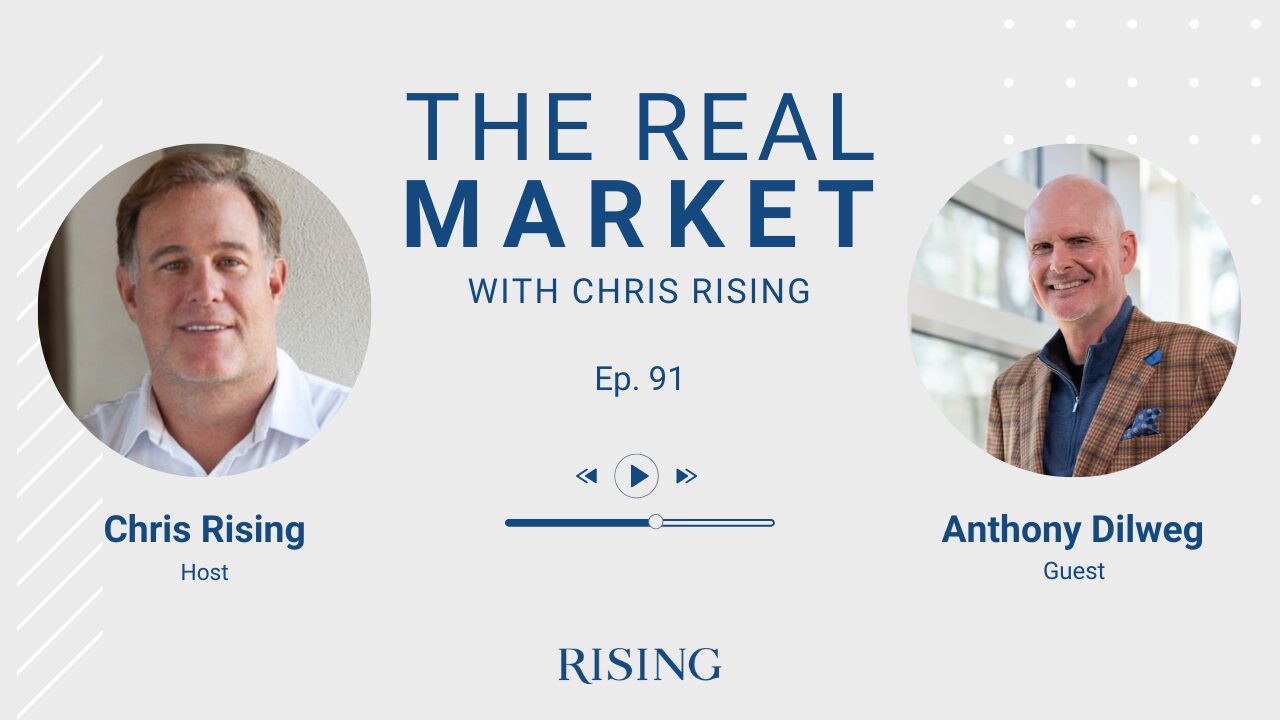
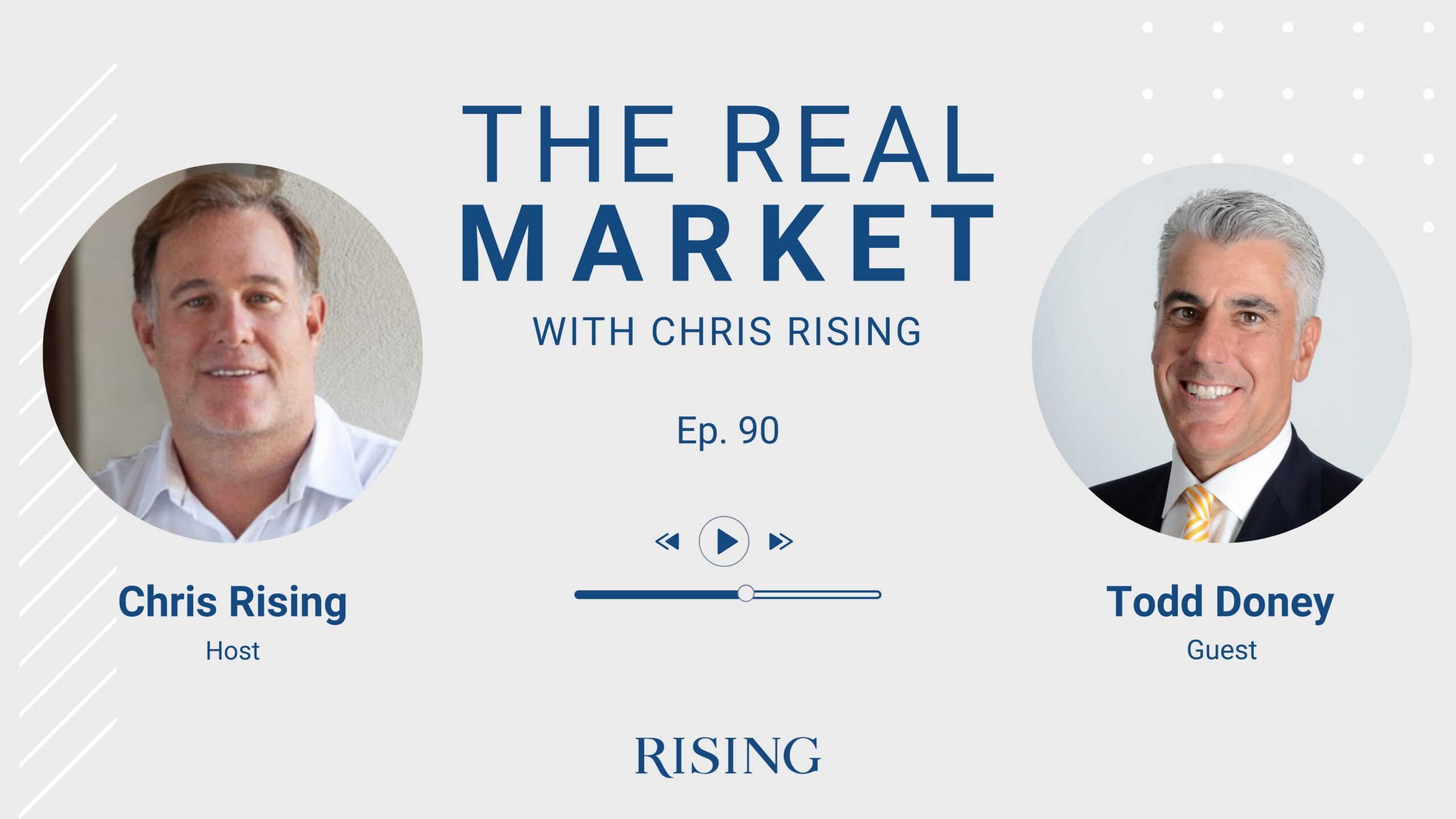
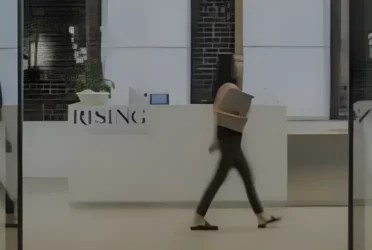 Our Company
Our Company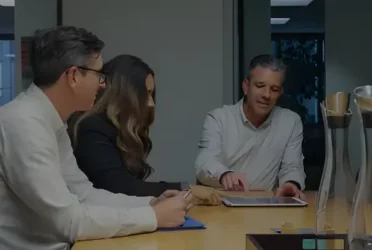 Our Team
Our Team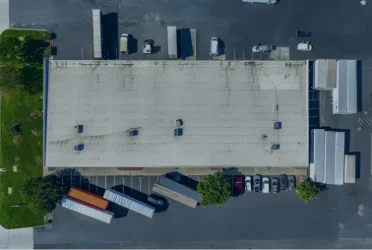 Portfolio
Portfolio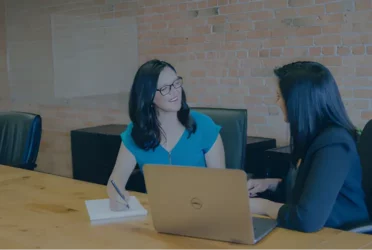 Services
Services News
News Insights
Insights Videos
Videos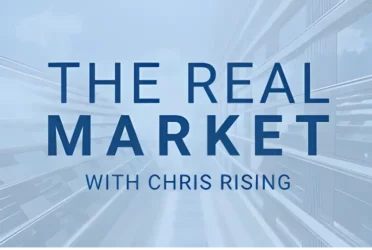 Podcast
Podcast